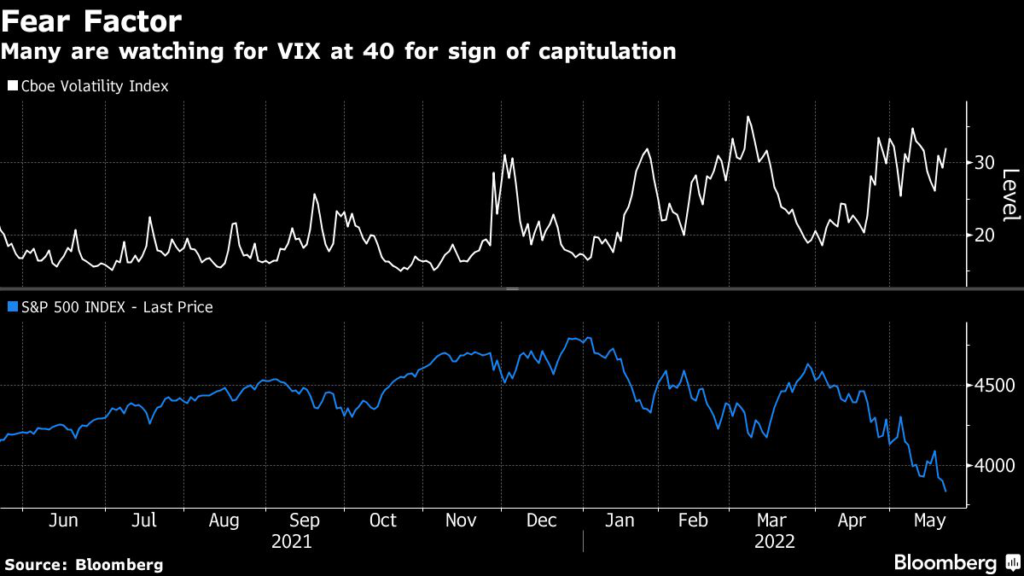(Bloomberg) — It’s been hard to watch, impossible to predict and a nightmare to trade. But has the S&P 500’s slide been an unqualified panic to date? By some measures no, and that might bode poorly for equities in the near term.
Even with the US stock benchmark plunging 20% from a record for the first time since March 2020, trading volume has been pretty average and the Cboe Volatility Index is below this month’s highs. Meanwhile, the Cboe SKEW Index — implied volatility for bearish S&P 500 put contracts relative to calls — is close to two-year lows.
The relative lack of anxiety isn’t necessarily a good thing, from contrarian lenses. That the S&P 500’s path has remained relatively orderly without any obvious sings of panic suggests that the bottom isn’t yet in view, according to AlphaTrAI’s Max Gokhman. Layer on a Federal Reserve that’s intent on looking past the turmoil in pursuit of tighter financial conditions, and the outlook is gloomy.
“Investors holding their breath may wind up passing out because there’s more to this drop before the roller-coaster year starts grinding back up,” said Gokhman, the firm’s chief investment officer. “With the Fed as the ride’s operator, we shouldn’t expect a gentle glide back to the station. Only one-third of tightening cycles ended without a recession and they all started when inflation was under 3.3%.”
Not Rushing for the Exits
The drop in stocks hasn’t been accompanied by a surge in trading. Volume on US exchanges hasn’t spiked this week as the S&P 500 fell another 4.8%. It’s remained in line with levels seen throughout the tumultuous year.
“Volumes are not impressive or overwhelming. I prefer to see a volume surge to feel more confident about a bottom,” said Chris Murphy, co-head of derivatives strategy at Susquehanna International Group. “We typically see more volume at a real low as a sign of capitulation.”
‘Fear Gauge’ Has Yet To Tremble
“We have fear, we have doubt, we have angst, but we don’t have capitulation. We don’t have people dumping stocks yet, and I think that will come,” SentimenTrader’s analyst Jay Kaeppel said in a Bloomberg Television interview Friday. “Wake me when it hits 45, because if you look at history, all the big declines, it spikes to 40 or 45, so 30 isn’t going to do it.”
The VIX is currently around 32.
Julian Emanuel, chief equity and quantitative strategist at Evercore ISI, is watching three things for signs of capitulation: the VIX above 40, the put/call ratio reaching 1.35, and share volume above 20 billion.
“The end of corrections are often accompanied by fear and capitulation — extreme volatility and trading volume,” he wrote in a recent note.
Craig W. Johnson, chief market technician at Piper Sandler, is also looking for the VIX to hit 40, and is utilizing a proprietary technical indicator he’s dubbed the “40-week technique,” which measures how many stocks are above or below their 40-week moving averages. That gauge has dropped to 13% and he’s waiting for a “sub-10% washed-out reading.”
“We have found readings below 10% have historically signaled the broader market is near an inflection point,” he wrote in a note.
Single-Stocks Signals
The Cboe SKEW Index — implied volatility for bearish S&P 500 put contracts relative to calls — is near the lowest since April 2020. Meanwhile, the put-to-call ratio that tracks the volume of options tied to individual companies has jumped to 1.27, still below the threshold Evercore’s Emanuel is watching for.
“Even if index volatility isn’t cracking, you are seeing it in single stocks,” said Amy Wu Silverman, an equity derivatives strategist at RBC Capital Markets. “If single stocks is cracking, eventually this leads up to the index level.” Wu pointed to reactions in Walmart Inc. and Target Corp. as examples — both earlier this week posted their biggest post-earnings drops in decades.
Keeping a Close Eye on Valuations
Mike Mullaney, director of global markets research at Boston Partners, says there’s potential for further margin contraction. “There’s probably more downside for the market right now than there is upside,” he said by phone.
He’s going to be looking for analyst revisions to come down and valuations getting lower.
“The $64,000 question is whether we can achieve a soft landing or are going to get pushed into a recession,” he said. “We’re more in the recession camp than we are in the soft-landing camp if the Fed wants to get to their inflation targets.” A recession could push the S&P 500 earnings multiple to around 13, and that could signal an area where “pretty much everything has been discounted in the market.”
More stories like this are available on bloomberg.com
©2022 Bloomberg L.P.











